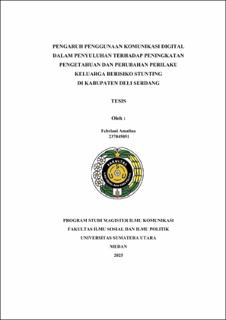| dc.contributor.advisor | Humaizi | |
| dc.contributor.advisor | Asmara, Sakhyan | |
| dc.contributor.author | Amalina, Febriani | |
| dc.date.accessioned | 2025-07-24T02:33:12Z | |
| dc.date.available | 2025-07-24T02:33:12Z | |
| dc.date.issued | 2025 | |
| dc.identifier.uri | https://repositori.usu.ac.id/handle/123456789/106627 | |
| dc.description.abstract | This study aims to analyze the effect of digital communication in counseling
activities on increasing knowledge and changing behavior among families at risk
of stunting in Deli Serdang Regency, as well as to examine the moderating role of
demographic factors such as age, education level, number of children, ethnicity,
and religion. The theoretical frameworks employed in this research are Everett М.
Rogers' Diffusion of Innovation Theory and Benjamin S. Bloom's Taxonomy
Theory. This study uses a quantitative approach with a sample of 353 families
selected through purposive sampling. Data analysis was conducted using simple
linear regression and moderation tests. The findings reveal that the use of digital
communication in counseling (X) has a positive influence on both knowledge (Y1)
and behavioral changes (Y2) among stunting-risk families in Deli Serdang
Regency. The R² value for knowledge is 0.168 and for behavior is 0.143. After
incorporating the moderating variables (age, education, number of children,
ethnicity, and religion), the R² values increased to 0.238 for knowledge and 0.204
for behavior, indicating that these demographic factors strengthen the relationship
between digital communication and the knowledge and behavior of the target
families. This study underscores the importance of contextually relevant and
adaptive digital communication strategies to enhance the effectiveness of stunting
prevention counseling programs. | en_US |
| dc.language.iso | id | en_US |
| dc.publisher | Universitas Sumatera Utara | en_US |
| dc.subject | Digital Communication | en_US |
| dc.subject | Counseling | en_US |
| dc.subject | Knowledge | en_US |
| dc.subject | Family Behavior | en_US |
| dc.subject | Stunting | en_US |
| dc.title | Pengaruh Penggunaan Komunikasi Digital dalam Penyuluhan terhadap Peningkatan Pengetahuan dan Perubahan Perilaku Keluarga Berisiko Stunting di Kabupaten Deli Serdang | en_US |
| dc.title.alternative | The Effect of Digital Communication in Counseling on Increasing Knowledge and Changing Behavior Among Stunting-Risk Families in Deli Serdang Regency | en_US |
| dc.type | Thesis | en_US |
| dc.identifier.nim | NIM237045051 | |
| dc.identifier.nidn | NIDN0009085906 | |
| dc.identifier.nidn | NIDN0017095605 | |
| dc.identifier.kodeprodi | KODEPRODI70101#Ilmu Komunikasi | |
| dc.description.pages | 203 Pages | en_US |
| dc.description.type | Tesis Magister | en_US |
| dc.subject.sdgs | SDGs 3. Good Health And Well Being | en_US |


